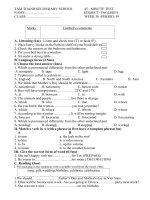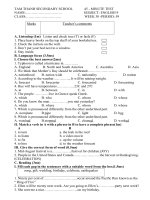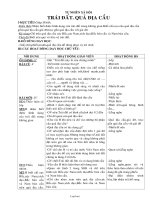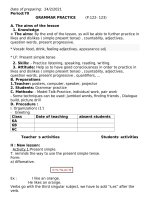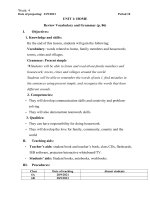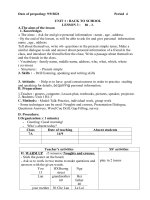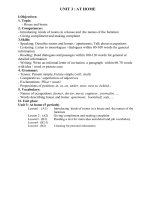KHBD TIẾNG ANH 9 TUẦN 30 TIẾT 59 60 UNIT 9 LISTEN READ
Bạn đang xem bản rút gọn của tài liệu. Xem và tải ngay bản đầy đủ của tài liệu tại đây (176.22 KB, 7 trang )
Date of preparing: 7/04/2021
Period 59
UNIT 9 : NATURAL DISASTERS
LESSON 3 : Listen
A.Objectives:
1. Aims: By the end of the lesson, students will be able to:
- Get to know some ideas on how to live with earthquakes through sentence
completion exercise.
- Listen to the talk better, identify and catch key words for the answers.
B. Teaching aids : Text book, pictures , poster.
2. Practice skill:
- Practice listening skill.
3. The knowledge needs to get:
+ Standard knowledge: Get to know some ideas on how to live with earthquakes
through sentence completion exercise.
+ Advanced knowledge: Get to know some ideas on how to live with earthquakes
through sentence completion exercise well.
4. Basic language:
- Vocabulary: - block ( v )- roller ( n )- Fixture (n)- zone (n) - doorway (n):
-earthquake (n) - drill (n) cuộc thực tập
5. Attitude:
- Help ss to have good consciousness in order to practice listening for details.
B. Teaching- aids: Textbook, pictures, posters, Cd, computer.
C. Methods:
- Model-Talk-Practice, individual work, pair work
- Some techniques can be used: Chatting, Prediction
D. Procedure :
I.Organization: ( 1 minute)
- Greeting: Good morning!
- Who’s absent today?
Class
Date of teaching
Absent students
9A
9B
Steps/ Activities
(4 minutes)
II. WARM UP
Chatting:
- Ask students some questions about earthquakes.
- Do you know anything about earthquakes?
- Are they dangerous?
- Are there many earthquakes in Vietnam?
- In which country do earthquakes unusually
occur?
Content
- What happens if there is an earthquake?
- What would you do if there was an earthquake?
III. NEW LESSON (25minutes)
I. Pre Listening :
1. Vocabulary :
1. ( prevent movement from happening ).
2. ( translation )
3. ( things fixed together in one position )
4. ( translation )
5. ( realia )
6. ( picture )
7. ( picture )
Sts : - listen.
- listen and repeat (chorally then individually).
- copy.
* Checking vocabulary: Slap the board
- Call on two students or two teams of students to the
ront of the class.
- Make sure they stand at an equal distance from the
board.
- Call out the definition or the synonym of the word,
the two students must run forward and slap the correct
word on the blackboard. The one who slaps the first
gets one mark.
- Continue until students have slapped all the words.
2. Prediction :
- Set the scene: A
" n expert is giving a talk on how to
live with earthquakes, Actually he will give us advice
on what should we do before and during an
earthquake. Listen to the talk and complete the table"
- Before listening to tape, let sts read the table
carefully make some useful guesses for the missing
words in the blanks.
- Give feedback.
II. While Listening :
- Have students listen to the tape twice and check their
prediction.
- Feedback and give correct answers. Play the tape
again and stop at each answer
* Tape transcipt:
If you live in an earthquake zone, you should take
some time to look around your house. Place heavy
books on the bottom shelf of the booshelves. Block the
rollers on your fridge and washing machine to
prevent them from moving. Put hanging potted plants
in plastic containers. Check the mirrors in your
1. Vocabulary :
- block ( v ): hạn chế, ngăn
chặn
- roller ( n ): trục lăn, con
lăn.
- Fixture (n): cố định vật ở
một chỗ
- zone (n) khu vực, miền;
vùng
- mirror
- doorway (n): lối cửa ra
vào
- earthquake (n) sự động
đất
- drill (n) cuộc thực tập
2. Listen :
Answer keys:
( 1 )bottom shelf of the
bookshelf.
bathroom and bedroom. Make sure they can’t move.
Don’t put your bed next to window.
Planning where you are going to be during an
earthquake is very important. The first thing to
remember is to stay inside. Then you should sit under
a strong table or doorway, or stand in the corner of a
room.
( 2 ) fridge.
( 3 ) washing machine.
( 4 ) mirrors.
( 5 ) a window.
( 6 ) inside.
( 7 ) under strong table.
( 8 ) doorway.
( 9 ) corner of a room.
III. Post- Listening :
- Ask Ps to write a short paragraph about living with
earthquakes. (May set it for homework)
IV. SUMMARY (2 minutes)
- Listening to complete a table about how to live with
earthquakes .
V. HOMEWORK (2 minutes)
Ask sts to write a short paragraph about how to live
with earthquakes, based on the information in the
table. Start with:
-Prepare the next lesson: Read
4. Homework :
If you live in an earthquake
zone, you should take some
time to look around your
house. ....
*. Evaluation:
......................................................................................................................................
............................................................................
......................................................................................................................................
...........................................................................
Date of preparing: 7/ 04/ 2021
Period 60
UNIT 9 : NATURAL DISASTERS
LESSON 4: Read
A.Objectives:
1. Aims: By the end of the lesson, students will be able to get
general background information on some common natural
disasters such as earthquakes, tidal waves, typhoon, volcanoes
and tornadoes through 2 comprehension exercise: "true/ false
and" " sentence completion"
2. Practice skill:
- Practice the comprehension reading skill.
3. The knowledge needs to get:
+ Standard knowledge: To get general background information
on some common natural disasters
+ Advanced knowledge: To write about natural disasters
4. Basic language:
- Vocabulary: Tidal wave, hurricane = cyclone = typhoon (n),
tornado (n), erupt ( v) suck up ( v ), shift ( n ), funnel - shaped
( adj ).
5. Attitude:
- Help ss to have good consciousness in order to get general
background information on some common natural disasters
.
B. Teaching- aids: Textbook, pictures, posters, Cd, computer,
video and the picture of natural disasters .
C. Methods:
- Model-Talk-Practice, individual work, pair work
- Some techniques can be used: Chatting, Prediction.
D. Procedure :
I.Organization: ( 1 minute)
- Greeting: Good morning!
- Who’s absent today?
Class
Date of teaching
Absent students
9A
9B
Steps/ Activities
II. WARM UP
(5 minutes)
Brainstorming:
Natural disasters
snowstorm, earthquake, volcano, typhoon.
* Chatting
- Give students some questions about the
four natural disasters.
. How do you know it is a snowstorm/
earthquake/ a volcano/ a typhoon?
. Have you ever experienced any of these
natural disasters? What happened? How
did you feel?
III. NEW LESSON (35minutes)
I. Pre Reading :
1. Vocabulary :
1. ( picture )
2. ( synonym: quick, sudden )
3. ( picture)
4. ( picture )
5. ( visual )
Content
Answer keys:
Snowstorm earthquake volcano - typhoon
Vocabulary :
- Tidal wave ( n ): sóng
thần
- hurricane = cyclone
= typhoon (n) bão
- tornado (n) cơn lốc
6. ( change to )
7. ( picture )
Sts : - listen.
- listen and repeat (chorally then
individually).
- copy.
* Checking vocabulary: Rub out and
remember
- Rub out the words one at time, each time
you torub out the word in English, point to
the Vietnemese translation and ask
students to repeat again. When all the
English words are rubbed out, go through
the Vietnamese list and get students to
call out the English words.
2. True - False statements predictions
- Set the scene: you are going to read a
passage about 5 disasters that we have
mentioned earlier. There are 6 statements
about the information of some natural
disasters. All of you have to read them and
guess whether they are true or false.
- Hang the poster of T/F statements ( on
page 79)on the board.
- Get students to work in pairs to guess
which statements are true and which are
false.
- Give feedback.
II. While Reading :
1. Reading and checking
- Have students read the text on page 78
and check their prediction.
Get students to correct false statements.
2. Complete the sentences:
- Have students work in pairs and
complete the sentences in exercise 5b on
page 79.
xoáy
- erupt ( v) phun (núi
lửa)
- suck up ( v ): hút lên
- shift ( n ): sự chuyển
dịch, sự thay đổi
- funnel - shaped
( adj ): có hình phểu
Read :
a) True or False
Answer key :
1. T
2. T
3. F A huge tidal wave
traveled from Alaska
to Ccalifornia.
4. T
5. F The eruption of
Mount Pinatubo is
the world’s largest
volcanic eruption in
more than 50 years.
6. T
b) Complete the
sentences:
Answer keys:
1. The majority of
earthquakes occur
around the Pacific
Rim.
2. During the
earthquake in Kobe,
many people were
killed when homes,
office blocks and
highways collapsed.
3. A tidal wave can
only occur when
there is an abrupt
shift in the
underwater
movement of the
Earth.
4. In Astralia, a
III. Post Reading :
tropical storm is
Asking and Answering:
known as a cyclone.
- Divide the class into four groups.
5. Christopher
- Have students read the text again.
Columbus gave us
- Group 1 ask a question, group 2, 3, 4
the word “typhoon”.
answer it.
6. A Tornado is a type
- Group 2 ask another question, group 1, 3,
of storm that passes
4 answer.
overland below a
- Go on until the four groups ask their
thunderstorm and
questions
sucks up anything
* Possible answers:
that is in its path.
1. Why do people call the Pacific Rim “Ring
of Fire”?
- Because 90% of earthquakes occur
around the Pacific Rim.
2. What will happen when there is an
abrupt shift in the underwater movement
of the earth?
- Tidal waves will happen.
3. What does “typhoon” mean?
- It means “big wind”.
4. Can we predict a volcano?
- Yes. The scientists can warn us about the
eruption.
4. Homework :
IV. SUMMARY (2 minutes)
- Reading a text about natural disasters in
the world.
V. HOMEWORK (2 minutes)
- Have students write the exercise 5b into
their notebooks, using their ideas.
-Prepare the next lesson: Write
*Evaluation :
